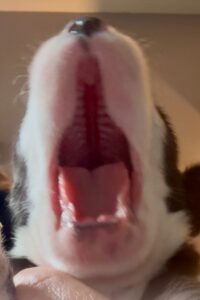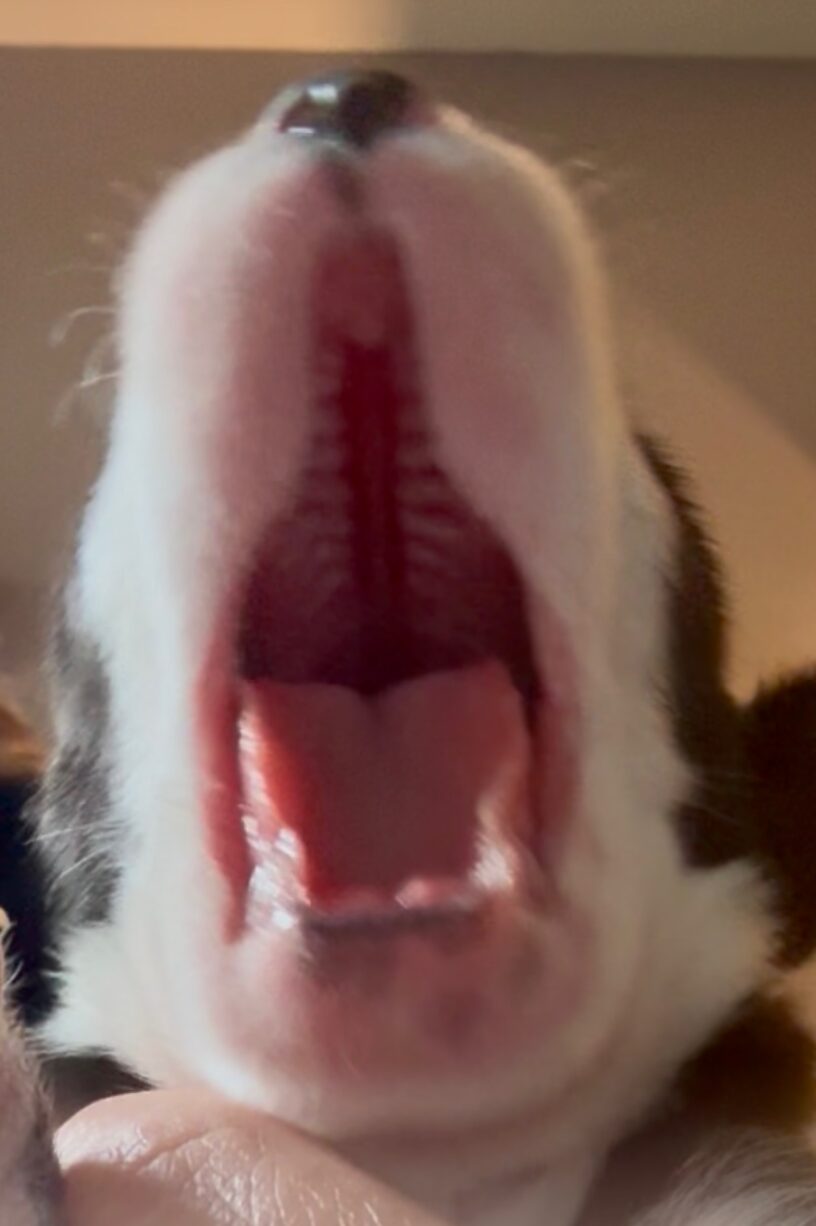They looked perfect at first glance—thirteen tiny Great Dane puppies, curled into one another, soft and warm, the size of your hand. But something wasn’t right with three of them. Quinn, Quira, and Quest weren’t latching to nurse. They were fussy, weak, and thin. Worse, milk was coming from their noses.
A veterinary exam revealed the diagnosis: cleft palates. It’s a condition that sounds simple but has life-threatening consequences for newborns. Their story is just beginning, but understanding what they—and many other puppies—go through helps shine a light on an often misunderstood and under-discussed medical condition in neonatal care.
What Is a Cleft Palate?
A cleft palate is a birth defect where the roof of the mouth doesn’t form completely during fetal development. In a healthy puppy, the two sides of the palate come together and fuse, creating a solid barrier between the mouth and nasal passages. In a cleft-affected puppy, that fusion never happens—or only happens partially—leaving a gap.
This gap can occur in the front (hard palate), the back (soft palate), or both. In some cases, the cleft extends into the lip as well, forming what’s known as a cleft lip.


Screenshot
Why That Gap Is So Dangerous
In a puppy with a cleft palate, feeding becomes dangerous. When they attempt to nurse, milk doesn’t just go down their throat—it can shoot up through the cleft and into their nasal cavity or lungs. This causes a condition called aspiration, where fluid enters the lungs, potentially leading to pneumonia, infection, and in many cases, death.
Unlike in older puppies or dogs, newborns are completely dependent on suckling for nutrition. If they can’t nurse or bottle feed safely, they can starve or develop life-threatening complications within hours or days.
Tube Feeding: The Lifesaving Alternative
Because cleft puppies cannot feed the traditional way, the only safe method is orogastric tube feeding. This method bypasses the mouth and delivers milk directly into the stomach.
How It Works
-
A soft, flexible tube (usually a red rubber catheter) is gently inserted into the puppy’s mouth and down the esophagus, stopping at the stomach.
-
The tube length is pre-measured (from nose to last rib) to ensure it reaches the stomach and not the lungs.
-
Warm formula is slowly injected through a syringe connected to the tube.
-
The tube is carefully removed, and the puppy is held upright and burped, just like a human baby.
Feeding Schedule
-
Newborns are fed every 2–3 hours, even overnight.
-
Formula volume is based on body weight, divided across feedings.
-
As the puppy grows, feedings become less frequent and volumes increase.
Why Technique Is Critical
Improper tube feeding can cause formula to enter the lungs, leading to aspiration. It can also cause stomach overfilling, regurgitation, and other complications. Puppies must be handled gently, with heads supported and bodies kept warm and stable throughout the feeding.
Caregivers must also monitor hydration, stool output, weight gain, and behavior, as cleft puppies are incredibly fragile during their first few weeks.
Clefts Rarely Come Alone: Other Midline Defects
Cleft palate is considered a midline defect, meaning it affects the central line of the body—where many other structures also form during fetal development. Because of this, it can be linked to other birth abnormalities.
Common Associated Defects
-
Hydrocephalus: A buildup of fluid in the brain’s ventricles, which can cause an enlarged head, seizures, or behavioral changes.
-
Heart murmurs or congenital heart defects: These may present with rapid breathing, fatigue, or poor growth.
-
Skeletal deformities: Including fused toes, shortened limbs, or malformed tails.
-
Umbilical hernias: Where abdominal contents protrude through a weakness in the abdominal wall.
-
Cleft lip: A separation in the upper lip, which may be cosmetic or may interfere with suckling or feeding.
These conditions vary in severity. Some are mild and correctable, while others may require long-term medical management or reduce a puppy’s life expectancy. Each puppy must be assessed individually, often with veterinary input from multiple specialists.
Medical Management and Milestones
The first 14 days are often called “the danger zone” for cleft palate puppies. Surviving that period is a major victory. If they make it to weaning, their prognosis often improves dramatically.
Critical Milestones in the First Weeks
-
Day 1–3: Establishing safe tube feeding, maintaining body temperature, and avoiding aspiration.
-
Week 1: Monitoring weight gain daily; healthy puppies should gain 5–10% of their weight each day.
-
Week 2–3: Eyes and ears begin to open. Mobility increases. Cleft puppies often lag slightly behind due to early trauma but usually catch up.
-
Week 3–4: Transition to gruel or softened solid food using elevated feeding methods to prevent food from entering the nasal cavity.
Throughout this time, caregivers must also manage environmental cleanliness, as cleft puppies are more prone to infection due to food or formula entering the nasal cavity.
Surgery: Often Unnecessary—and Sometimes Risky
While it’s commonly assumed that cleft palate puppies require surgery to live normal lives, the reality is quite different. In fact, most cleft puppies do not require surgical repair at all.
Why Surgery Isn’t Always the Right Choice
For many cleft puppies, careful feeding techniques and lifestyle adjustments are enough to allow them to grow and thrive without intervention. Surgery is typically considered only in cases of severe clefts that continue to cause complications as the puppy matures.
Even when surgery is performed, it comes with notable risks and a high failure rate—especially in puppies under one year of age. The palate is a delicate area, and healing can be complicated by scar tissue, infection, or reopening of the cleft (fistula formation). Multiple surgeries are often needed, and outcomes are not always successful.
Thriving Without Surgery
Most cleft palate puppies—especially those with soft palate involvement or small hard palate clefts—can live completely normal, healthy lives. With proper feeding (including hand feeding or elevated bowls), most can eat solid food without issue.
These dogs require no medications, no ongoing interventions, and often no limitations whatsoever in daily life. Their cleft is simply part of who they are—not a disability, but a difference.
Final Thoughts: Fragile Starts, Resilient Spirits
Quinn, Quira, and Quest may have started life with a defect, but it doesn’t define them. What defines them is their will to live, their ability to overcome challenges, and the way they respond to the care and love poured into them each day.
Cleft palate is not a death sentence. With knowledge, patience, and appropriate care, cleft puppies grow into dogs that thrive. Their journey is not easy—but it is full of hope, progress, and second chances.

